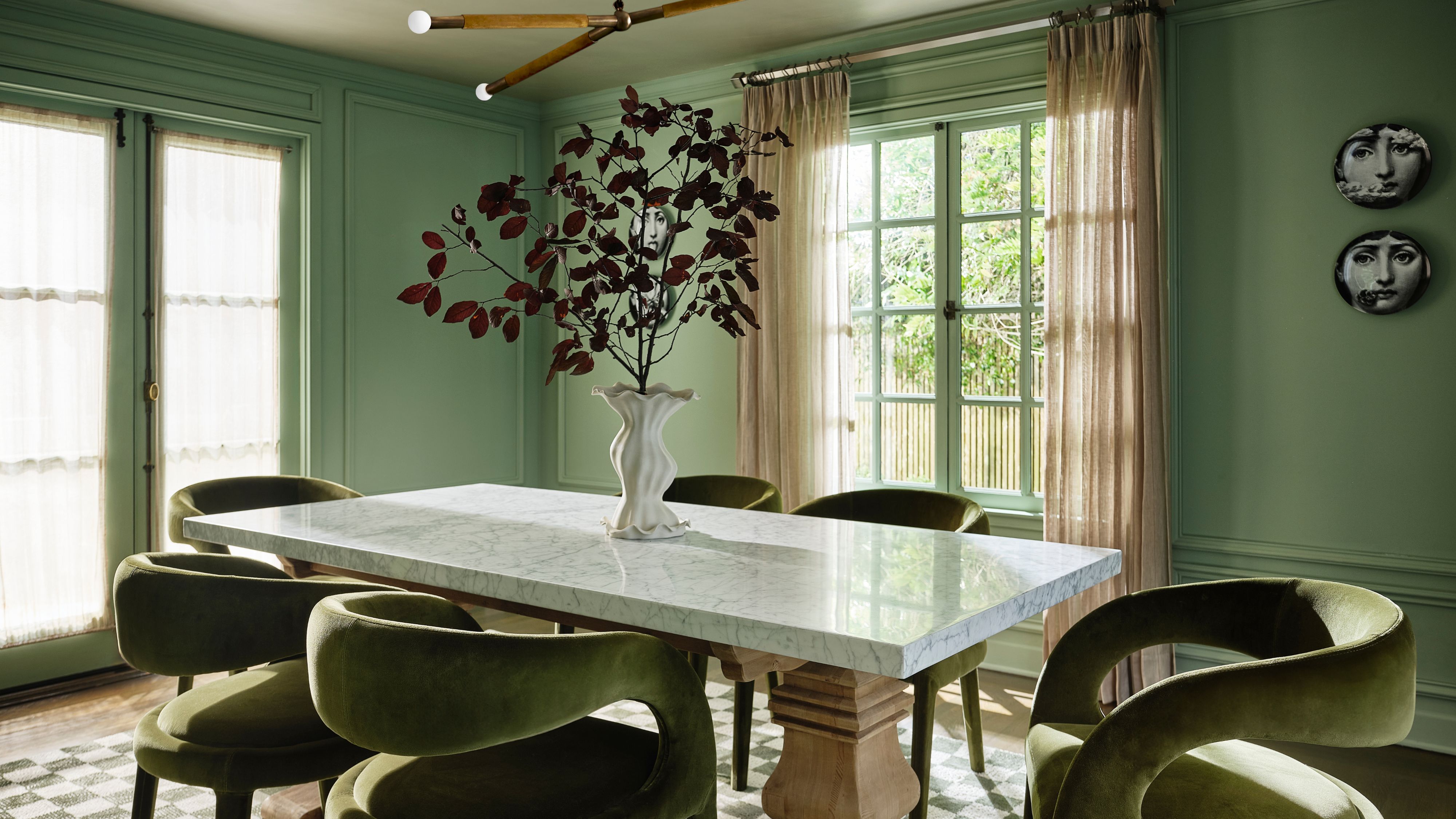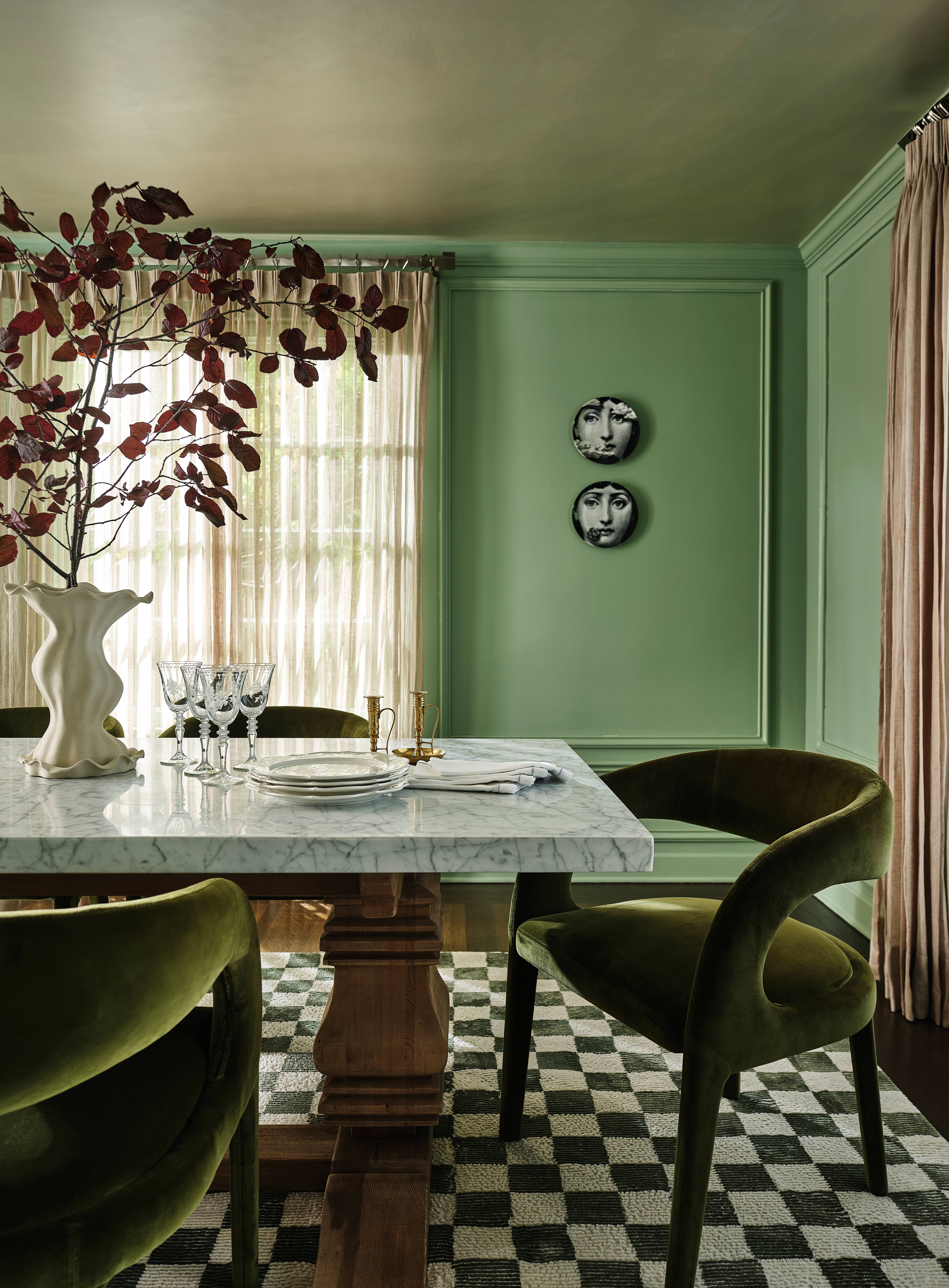
Modern design is often accused of being all polish, no poetry — a touch too sleek for its own good. But every so often, a room like this comes along, reminding us that restraint and richness aren’t opposites, but two sides of the same coin.
Tucked inside a 100-year-old Tudor in San Francisco is a dining room so saturated in green, it’s made us a little green ourselves. The project comes from Atelier Oleana, the local design studio helmed by Anu Jain, a trained lawyer, former tech executive, and now, a design name worth knowing. She’s earned a reputation for merging historic architecture with fresh, unexpected details, and this project, with its carved beams, leaded glass, and layered textures, proves the point.
There were a few goals from the outset: 1) honor the home’s Tudor heritage, 2) nod to the “intellectual design culture” of San Francisco — a city Anu describes as having “a certain irreverent elegance” — and 3) weave in the dualities of her own life, especially the dialogue between California and India.
Because this wasn’t just any project — it was personal. Anu designed the home for herself, her husband, and their two young children. “It was, as they say, love at first sight,” she tells Livingetc.

“What drew me in immediately was the contrast — the stately Tudor architecture paired with the potential to inject a sense of play and contemporary expression," she continues. "We have deep roots in both California and Asia, so we wanted our home to reflect that cultural heritage as well. I just love that this house allowed us to explore so many different dualities.”
You may not be reimagining a 1920s Tudor anytime soon, but the way this room uses tradition not as a restriction, but as a launchpad, is a masterclass. Here, Anu shares how to bring the look home.

“The dining room is the emotional anchor of the house — intimate, grounded, and rich in color,” Anu explains. “I wanted to preserve that gravitas but introduce levity.”
The original bones stayed: the open layout, which, she notes, “invites communal, lingering meals, reflecting the way we gather in Indian homes,” and the leaded windows, still fitted with their original cremone bolts, now framed with new paneling and molding designed to enhance rather than upstage.
From there, Anu layered in her signature novelty: linen sheer curtains for softness, brass inlays for warmth, sculptural lighting, and strategic flashes of unexpected color.
Apparatus’ Arrow chandelier — a tour de force of metal and suede — crowns Anu’s dining room. While the original will set you back over $5,000, this similar style offers a similarly pointed, architectural effect at a far gentler price.
For maximum visual impact, play to opposites. In a space drenched in green, even a small spring of deep plum faux foliage delivers an outsized punch.
Light was treated like a design material here — and for good reason. These linen panels, available in a range of sizes, offer softly diffused light, movement, and texture, while maintaining just enough privacy.
She credits three elements in particular for giving the room its distinct punch. First: an old Restoration Hardware pedestal table of oak wood and Carrara marble.
Second: a checkered rug that “speaks to the maximalist artistry of Indian interiors.”
Third: wall-mounted Fornasetti plates that lend a hint of quirk. “They all play distinct roles in shaping the room’s personality,” she says.
“The double pedestal allowed for more fluid seating and echoed the verticality of the Tudor paneling without being literal,” notes the designer. While her exact piece is no longer available, this mixed wood-and-Carrara version is strikingly close — complete with a light wood double pedestal.
"I loved the tension of the check — it's both classic and bold," says Anu. "By choosing green tones, we kept the cool factor. It brings an almost trompe-l'œil element to the room, teasing the eye without overwhelming the senses." This option from Rugs USA strikes a similar chord, with a green just dark enough to anchor the walls while remaining shaggy and soft underfoot.
Wondering how to style plates not meant for eating? Don’t overthink it. "The trick is asymmetry with intention — let them tell a story rather than form a grid," Anu advises. She chose Fornasetti for its subtle surrealism: "His work adds just the right wink to a formal space. It's that blend of elegance and eccentricity that speaks to me."
But the real star is the color. Nowhere else in the home will you find a green quite like it. “It diverges slightly in palette — the color drenching is richer and more cocooning — but ties back through continuity of materials like burnished metals, warm woods, natural stone, and rich velvet upholstery,” Anu explains. “It’s where tradition meets a bit of drama.”
Color, she says, has never been intimidating. “The biggest thing I take from my Eastern heritage is being unafraid of color,” Anu says. Still, it was the home’s lush gardens that pushed her toward this particular green: “It felt like they wanted to spill inside. It’s the perfect mix of old and new.”
The shade in question is Farrow & Ball’s "Whirlybird," a green paint Anu calls “grounding but also slightly rebellious — a rich, moody hue that made the antique woodwork feel fresh rather than heavy.”
It’s impossible to miss the sculptural vase at the center of the table — a piece that feels like fabric caught mid-sway, frozen in opaline. Originally designed exclusively for the Evars Collective Entry at the San Francisco Decorator Showcase in collaboration with Quebec-based artist Karen Quirion, it’s a true showpiece. But if you're on a budget, this Amazon version captures a similar spirit at a much easier price point.
The seats in this SF dining room are vintage originals, reupholstered in Pierre Frey's Teddy Mohair. While the exact pieces are elusive, these Anthropologie dining chairs offer a close match with their mid-century-inspired ease and similarly soft texture.
Old and new — honoring what’s there while opening the door for something bolder — is the animating force throughout: “a centuries-old silhouette of a room reinterpreted with bold color, high-contrast elements, and global pieces that reflect the city's international spirit.”
This Tudor dining room proves that modern design isn’t the enemy of sentimentality. It doesn’t have to be cold, or clinical, or erase history to feel fresh. It can have color — and soul.
Speaking of color: San Fran seems to be bringing it back. Take a look inside this elegant — and infectiously playful — colorful San Francisco home that's showing us exactly how it’s done.







